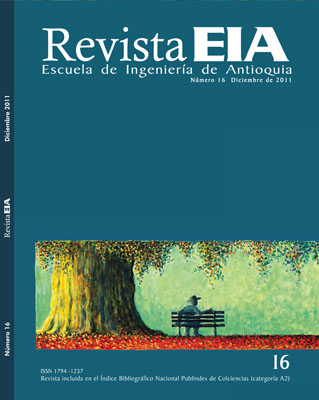OPTIMIZACIÓN DE UNA RED DE TRANSPORTE COMBINADO PARA LA EXPORTACIÓN DEL CARBÓN DEL INTERIOR DE COLOMBIA(OPTIMIZATION OF A COMBINED EXPORT COAL TRANSPORT NETWORK FROM THE INTERIOR OF COLOMBIA)
OPTIMIZACIÓN DE UNA RED DE TRANSPORTE COMBINADO PARA LA EXPORTACIÓN DEL CARBÓN DEL INTERIOR DE COLOMBIA(OPTIMIZATION OF A COMBINED EXPORT COAL TRANSPORT NETWORK FROM THE INTERIOR OF COLOMBIA)


This work is licensed under a Creative Commons Attribution-NonCommercial-NoDerivatives 4.0 International License.
Copyright statement
The authors exclusively assign to the Universidad EIA, with the power to assign to third parties, all the exploitation rights that derive from the works that are accepted for publication in the Revista EIA, as well as in any product derived from it and, in in particular, those of reproduction, distribution, public communication (including interactive making available) and transformation (including adaptation, modification and, where appropriate, translation), for all types of exploitation (by way of example and not limitation : in paper, electronic, online, computer or audiovisual format, as well as in any other format, even for promotional or advertising purposes and / or for the production of derivative products), for a worldwide territorial scope and for the entire duration of the rights provided for in the current published text of the Intellectual Property Law. This assignment will be made by the authors without the right to any type of remuneration or compensation.
Consequently, the author may not publish or disseminate the works that are selected for publication in the Revista EIA, neither totally nor partially, nor authorize their publication to third parties, without the prior express authorization, requested and granted in writing, from the Univeridad EIA.
Show authors biography
Se estudia una red de transporte combinado en Colombia, con horizonte en el año 2019, con el propósito de identificar las rutas óptimas del carbón desde los distritos de producción localizados en el interior del país
hasta los puertos marítimos de exportación. La metodología utilizada se basa en la búsqueda de solución a un problema de flujo de mínimo costo que considera la red de transporte por carretera, la fluvial y ferroviaria, en un modelo que contiene 34.000 km de red representados en 1.864 arcos. El modelo considera nuevas infraestructuras ferroviarias y portuarias y sugiere que se deben transportar los carbones del interior del país por el puerto de Barranquilla mediante estrategias de integración ferroviaria-fluvial y carretera-fluvial. Se resalta la importancia del río Magdalena como infraestructura estratégica de transporte y se identifican tres centros de transferencia de carga localizados en Barrancabermeja, Bocas del Carare y Capulco, que en conjunto llegarían a manejar 18 millones de toneladas de carbón al año.
Abstract: A combined transport network is studied with planning perspective in 2019, in order to identify optimal routes for transporting coal from centrally located sites within Colombia to export ports. Methodology based on the solution to minimum cost flow problem is used, including transport networks: road, river and railway, in a model composed of 34.000 km represented in 1.864 links. Both new rail and new export port infrastructure are included in the model. Model indicates centrally located coal within Colombia must be transported through the port of Barranquilla, using integration strategies, such as rail-river and road-river. The importance of the Magdalena River as strategic transport infrastructure is highlighted and three cargo transfer centers are identified near Barrancabermeja, Bocas del Carare and Capulco, which together could handle 18 million tons of coal per year.
Article visits 1303 | PDF visits 319
